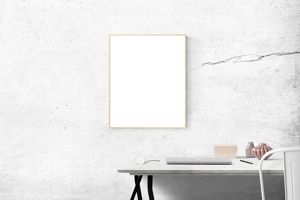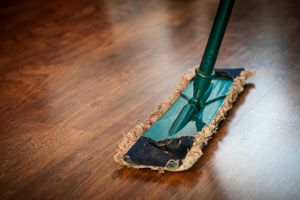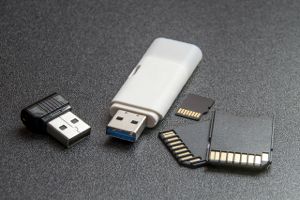Spring is here. How does your home office or writing niche look?
If you’re like most writers, things could use a little sprucing up. You’ve likely had some clutter collect over the winter, not only on your physical spaces, but in your technological ones, too. And clutter has been linked to stress in studies—definitely something you don’t need!
To get that fresh-start feeling that’s so good for your brain and creativity, take a few hours out of your weekend or evening to do a little cleaning. It’s not the most exciting thing to think about doing, but when it’s done, I promise you’ll be even more motivated to get back to writing.
7 Steps to Clean Your Physical Space
Let’s start with your physical space. This is the part that affects you most directly each day when you sit down to write.
 1. Clean off your desktop.
1. Clean off your desktop.
This is the obvious one, right? But it is the most important, because it’s the first thing you see when you go into your writing space. If you’ve got papers, files, knick-knacks, and other things in the way, you’re going to feel tired before you even start.
Take everything off the desk and set it either on the floor or on another surface nearby. Then give the desk a good cleaning either with soap and water or an appropriate wood cleaner/polish. You want to begin with a clean surface.
Next, go through everything you took off the desk and consider carefully before you put it back on. Your best bet is to keep your desk as clear as possible, with only a few knick-knacks that make you happy when you look at them. Papers, files, pens, notebooks, and other items should be put away somewhere, either in drawers, on shelves, or in storage containers underneath the desk.
Think twice, too, about some of the pictures and other keepsakes you usually have sitting on the surface. Are they old, out of date? Do you have old writing conference items or other things you’ve gathered over time that could now be donated or thrown away? Might you change them up to spark some new creative energy? How about something new to celebrate your updated space?
2. Go through all those papers.
You’d think with everything going electronic these days we wouldn’t have so many papers to accumulate, yet they still manage to stack up! This is the time to go through them, sort them, and discard as many as you can. It may help to create three piles:
- Shred
- File
- Back on desk
Those you need to keep are best filed away in a filing cabinet or drawer. If you have some papers you absolutely need within arm’s reach, organize these in open file stacks so it’s easy to find what you’re looking for when you need to.
Another good idea—scan as much of your paperwork as you can and create digital files for them, instead.
 3. Clean out the filing cabinet.
3. Clean out the filing cabinet.
Before you go filing all those papers you just sorted out, go through the filing cabinet first, and sort the papers into “keep” and “shred” piles. The idea is to get rid of old records you don’t need to keep anymore, and make room for the new papers you’re putting in.
If you don’t have a filing cabinet, clean out your filing boxes, or get some new ones (or a new filing cabinet). Having somewhere to keep your papers organized is critical to an open, refreshing workspace.
4. Clean the surrounding space.
Now that you’ve cleaned off the desk and the filing cabinets, it’s time to look around. What’s on the floor around the desk? Have you dropped stuff there that could be put away? Are there things there that don’t belong in your writing space? This is the time to put those back where they belong. You want this space to nourish your creativity, so you don’t want other things around that are going to distract you.
Check the walls. Do you have things hanging there that inspire you, or are they just old pictures that don’t mean anything to you anymore? Re-evaluate what you have around you when you’re writing, and think about how you can improve that space. How’s the paint? Could the wall use a new color to help improve your focus and attention, or give you energy?
 5. Clean out your supply drawer.
5. Clean out your supply drawer.
Okay, now it’s time to clean out what may be the dirtiest place in your writing nook—that little supply drawer that serves as a catch-all for everything from pens and sticky notes to your half-eaten candy bar. Dump the whole thing out, clean out the drawer itself (it’s amazing how much dust and junk can accumulate in these things), then think twice before you put everything back.
It’s best to store extra staples, notepads, pens, rulers, tape, and the like in some sort of storage area either under, around, or away from the desk. Just keep the bare bones of what you need in that drawer. You may also want to consider drawer dividers to help keep this and other drawers more organized—and to help you find what you need more quickly.
You can also use Ziploc bags to store smaller items like paper clips, loose staples, rubber bands, etc.
6. Tend to your houseplants.
Houseplants help clean out the air around your writing space. If you don’t already have some, it’s a good idea to get some. If you do have some, use your spring-cleaning time to give them a little attention.
Plants have a way of growing out of their pots, so either repot the ones you have, or trim them back so they’re more comfortable where they are. Repotting once in awhile helps refresh the soil anyway, so it’s a good idea even if space isn’t an issue.
You may also want to dust off the leaves. Simply clean them off with a soft, damp cloth.
 7. Go through your bookshelves.
7. Go through your bookshelves.
Most writers have bookshelves around their writing space, so don’t neglect these on your spring-cleaning day. Go through all your titles and make sure you still want to keep them all. You can donate any that you’re pretty sure you won’t read again to the library or to a used bookstore.
Outdated reference books, old text books, and others may be good candidates for the donating box. Then you may want to reorganize those that are left by genre and/or author. Finally, don’t forget to dust off the shelves so you’re starting fresh.
7 Steps to Clean Your Technological Space
Okay, now that your physical space is looking a lot better, it’s time to tackle your technological space.
 1. Clean off your computer, keyboard, monitors, and mouse.
1. Clean off your computer, keyboard, monitors, and mouse.
First, clean all the dust, fingerprints, and germs off your equipment. Use an air blaster for your keyboard, and make sure you use only an official cleaner and cleansing solution made for computer and tablet screens to avoid harming the surfaces.
You can make your own safe solution by mixing equal parts rubbing alcohol and distilled water in a spray bottle. (Don’t use tap water—it can leave residue behind.) Just be sure to check with your manufacturer’s instructions first, as some advise against using alcohol.
You can also use a disinfectant wipe to clean off your keys and your mouse, helping to get rid of any germs that may be lurking on them.
2. Untangle all those cords.
Depending on how many gadgets you have, your cords could be a tangled mess right now. There’s your computer, your phone, your USB hub, and possibly your keyboard and tablet, too.
First, change whatever you can to wireless—your keyboard and mouse are the easiest. Consider placing elsewhere those items you don’t typically use while writing, just to clear some space. Placing your phone or tablet in another room, for example, not only opens up your workspace, but may also help you cut down on distraction.
Make sure you’re using a surge protector to protect all your equipment. You may also want to look into Dotz cord identifiers, too, to help you quickly see which cord goes to what. Dotz has handy cord wraps, too, to keep all the extra cord length out of sight. Twist-ties also work to keep them compact.
 3. Clean out your inbox.
3. Clean out your inbox.
Time to tackle that email. You’ve probably got a lot of messages built up in your various folders. Start with the oldest messages first. Reply to them, delete them, or create a new email folder to keep them in.
One of the things I do to help me keep a cleaner email box is to save any emails I need to keep for records with the project they apply to.
So emails concerning a client’s ghostwritten book, for example, are saved to the corresponding project folder on my computer, taking them completely out of my email program. That way if I need to look something up, it’s right there with the project files. I’ve been using this method for years and it really works for getting old emails out of the way, but still keeping a record of them as needed.
Remember that excess emails create stress just like excess clutter. Your best approach is to get rid of as many as you can. Good options include newsletters you haven’t had time to read, product ads, emails that apply to projects that have long since been completed, etc. It’s also smart to go over all the newsletters you’re subscribed to, to make sure you still want to continue to receive them.
Once you’ve cleaned the program out, consider creating new folders that will help you organize future emails. You may want to create a folder titled, “Newsletters,” for example, that you can then move all newsletters into when they arrive. Then you can read them when you choose to, rather than feeling pressured to do so right when they arrive.
You can do the same for other types of emails. Make the organization work for you.
 4. Clean off your digital desktop.
4. Clean off your digital desktop.
Your on-screen desktop is a lot like your physical desktop. If it’s full of clutter, like old folders, photos, and other separate items, it’s going to create some stress, just like extra stuff on your desk does.
Go through your desktop and place all the items there in organized folders. Then pick a new image to have on your wallpaper—one that inspires and motivates you to write!
5. Toss or donate the old stuff.
Look around at your electronic equipment. Have you got old cell phones lying around? Old computers, tablets, or other gadgets? Think seriously about whether you still need all these. Best Buy will take many of these back in their recycling program.
You can also donate old computers to schools and libraries. Just transfer all your data to a cloud or to a portable hard drive, and then take your internal hard drive to be wiped. (A computer repair store can help you with that.)
Check too for any old CDs, memory sticks, floppy disks (yes, some of us still have these!), and old portable drives you can no longer use. For information on how to destroy the data on all these, check out this article from Davey Winder over at Alphr.
 6. Lighten the memory load.
6. Lighten the memory load.
Now it’s time to go into the files on your computer and get rid of anything you’re no longer using. You can either delete it, or if you think you may need it sometime in the future, transfer it to a large-capacity memory stick. Getting all the old stuff off your computer can help you focus in more attentively on the projects you’re working on now.
For my freelance work, for example, I typically go through all my files once a year. Old clients that I no longer work with go into one folder, while old projects from current clients go into other folders, then they all go onto a memory stick. If I find after a few years that I haven’t had to look any of these up, I know I can delete them completely.
Photos are another area to go into and organize, as they can take up a lot of memory. Again, you can organize them into folders and place them either on a cloud or a portable memory device.
7. Get rid of the old apps.
Remember those applications you downloaded five years ago? You probably don’t, so now’s the time to go through and delete those you’re no longer using. Cancel any accounts you have associated with these apps as well. Consider getting rid of old messaging apps, dieting and fitness apps, and anything else you’re no longer using.
The more of these you get rid of the more space you’ll open up on your computer, and you’ll also help protect your digital data overall.
How do you spring clean your writing space?

